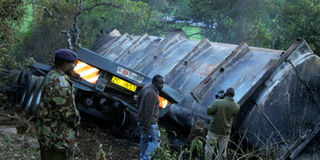Premium
Reckless greed, not poverty, to blame for high number of tanker tragedies

A shell of the petrol tanker that burst into flames at Kapokyek on the Kericho-Kisumu road on Tuesday night. Photo/JACOB OWITI
What you need to know:
Fuel looters know as well as anybody that petrol is flammable but they ignore risk
There was Sidindi in Ugenya and Banana Hill in Kiambu. Then came the Sachang’wan fuel tanker tragedy which took the lives of 130 villagers near Molo on January 31. The burns of some of the Sachang’wan survivors are yet to heal. Six are still in hospital.
And on Wednesday, yet another villager died while 47 others are in hospital after being burnt at Kapokyek near Kericho Town when another tanker from which they were looting fuel exploded. That the villagers would — again— embark on such a suicidal mission barely four months after the Sachang’wan mass burial is mind-boggling.
Critical condition
It has become cliché to ask whether Kenyans ever learn from any tragedy — self-inflicted or otherwise. Clearly, the 47 injured in the latest incident did not learn from previous tragedies.
Early this week, Kisumu residents fought with police officers who had blocked them from scooping diesel from a tanker that had rolled on the roadside. One of them said they should be allowed to scoop the diesel, even if it meant dying like the Sachang’wan victims.
So is it poverty, reckless greed, a misguided sense of adventure or plain stupidity that drives dozens of people into puddles of petrol, knowing fully well that by doing so they are putting their lives in mortal danger?
The fuel looters know as well as anybody else that petrol is flammable and that rushing to steal it from a tanker is to expose themselves to near certain death or serious injury. They know this because they saw it at Sachang’wan. So, why do they still do it?
It would appear that fuel looters are motivated by the same sadistic greed that drives those who profit from robbing road accident victims. The anger in the words and faces of two Cabinet ministers, an assistant minister and six MPs who visited the scene of the Tuesday night tragedy told it all.
The leaders ruled out ignorance and poverty as the forces that drive dozens of people to risk their lives to steal highly inflammable fuel from oil tanks.
“Cases where people have continued to siphon fuel from tankers after accidents cannot be as a result of ignorance because these cases are now common and their devastating effects are felt by many… People are just being irresponsible,” said Agriculture minister William Ruto.
Roads minister Franklin Bett urged the public to flee from scenes of accidents involving fuel tankers. “Why are we not learning and seeing that it is dangerous to go near an overturned oil tanker? If you decide to die, we cannot stop you.”
The two had led a team of Rift Valley MPs to the scene of Tuesday’s tragedy. Oblivious of the inherent danger, the villagers had rushed to siphon the fuel, but an attempt to steal a battery ignited a fire that quickly consumed acres of thickets near the lorry and left a trail of injuries and destruction in its wake.
A man died, while eight, who were in critical condition, were airlifted to Nairobi for specialised treatment. The rest, who were being treated at the Kericho District Hospital, were said to be out of danger. Mr Zakayo Cheruiyot, the Kuresoi MP, said greed and not poverty or ignorance was to blame for increased cases of people scooping fuel from overturned tankers.
“We shall always blame such incidents on poverty, but these are cases of pure greed,” he said and asked Kenyans to start re-evaluating their values. “Even if you are looking for money, let it not be a means by which you destroy your life.” According to him, most of the victims were youths between the ages of 18 and 25.
Additional reporting by Patrick Mayoyo and Cosmas Butunyi




